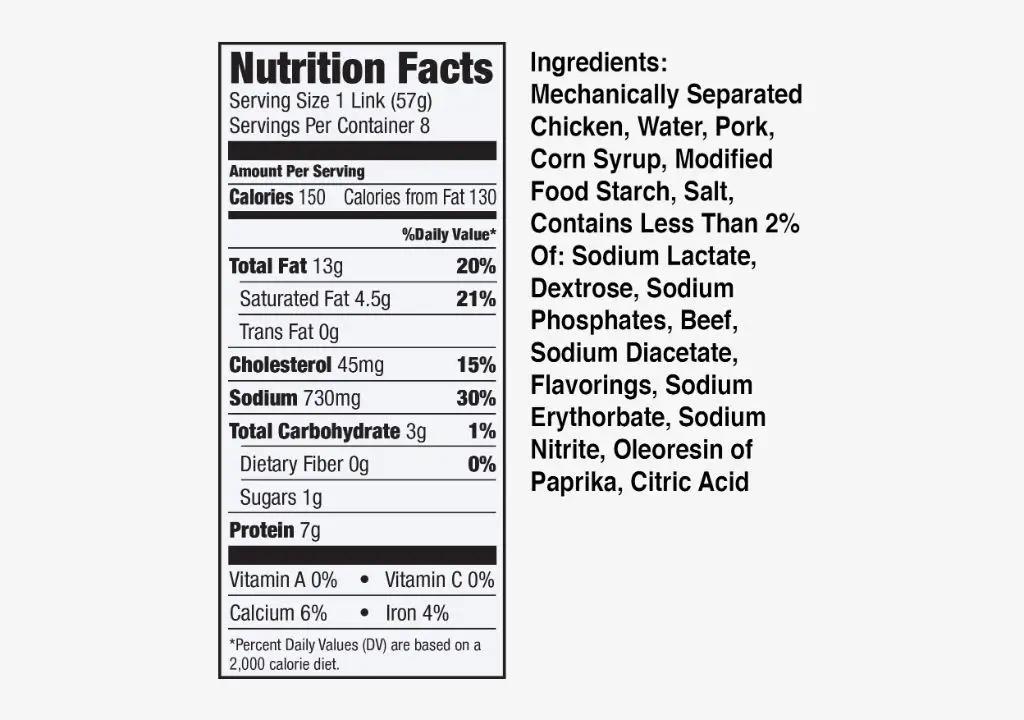Introduction
Nathan’s Famous hot dogs have a long and storied history. The original Nathan’s hot dog stand opened in Coney Island, New York in 1916 by Polish immigrant Nathan Handwerker. Using a secret spice blend, Nathan’s hot dogs quickly became favorites among New Yorkers and tourists visiting Coney Island. The Nathan’s brand has expanded across the country, but the hot dogs remain largely unchanged from the original 1916 recipe.
Traditional Nathan’s hot dogs contain a mix of beef, pork, and mechanically separated chicken. The exact ratio of meats is proprietary, but beef and pork make up the majority. Nathan’s hot dogs also contain spices, water, corn syrup, salt, sodium phosphate, potato starch, milk protein, and sodium nitrite as a preservative. Natural casings are sometimes used to give the hot dogs their signature snap when bitten into.
Meat Ingredients

Nathan’s hot dogs contain a blend of pork, beef, and poultry. The specific ratio of meats can vary between recipes, but pork and beef generally make up the majority. Ground pork and beef provide the signature hot dog taste and texture.
Nathan’s states that they use only quality cuts of 100% beef and pork in their hot dogs. The meat is sourced from cattle and hogs raised by farmers in the Midwest United States. Nathan’s has strict standards for meat selection, choosing only premium cuts and trims to ensure great flavor in every bite. They do not use any meat by-products, artificial flavors, or fillers in their hot dog meat blend.
Other Animal-Derived Ingredients
In addition to meat, Nathan’s hot dogs contain other animal-derived ingredients like animal fat and dairy products.
Animal fat provides juiciness and flavor to hot dogs. The animal fat in Nathan’s hot dogs likely comes from pork, beef, or a combination of meats. It helps retain moisture so the hot dogs are tender when cooked.
Nathan’s hot dogs also contain small amounts of dairy ingredients like milk or cheese. These dairy ingredients enhance flavor and texture. For example, dry milk powder contributes a subtle creamy taste.
Vegetable-Based Ingredients

Some of the key vegetable-based ingredients in Nathan’s hot dogs include onions, garlic, and various spices and seasonings that add flavor to the hot dogs.
Onions are an important ingredient in many hot dog recipes. They provide moisture, texture, and flavor. Diced onions are often added to the meat mixture during manufacturing. Powdered onions may also be used.
Garlic is another common vegetable-based ingredient. It adds an aromatic, pungent flavor that enhances the overall taste profile. Garlic powder is frequently used rather than fresh garlic.
Spices and seasonings also play an important role. These can include salt, black pepper, paprika, coriander, nutmeg, oregano, thyme, cumin, and more. The specific blend of spices helps create the signature flavor Nathan’s hot dogs are known for.
Overall, onions, garlic, spices, and various other vegetable-based ingredients complement the main meat components and give Nathan’s hot dogs their characteristic taste that people enjoy.
Preservatives and Artificial Ingredients
Nathan’s hot dogs contain several preservatives and artificial ingredients to help maintain freshness and enhance flavor.

Sodium nitrite is commonly added to processed meats like hot dogs to prevent bacterial growth that can cause botulism. While there are some health concerns around nitrites, they are strictly regulated and the amounts used in hot dogs are generally recognized as safe by regulatory agencies.
Other preservatives found in Nathan’s hot dogs include sodium phosphates, which help retain moisture, and sodium erythorbate, which promotes color retention. Artificial smoke flavoring, caramel coloring, and natural flavorings are also added to help achieve the expected hot dog taste and appearance.
The artificial smoke flavoring contains compounds like guaiacol and pyrazines to replicate the smoky aroma. Caramel coloring provides the characteristic light brown hue. Natural flavors are likely proprietary blends of compounds that add to the overall flavor profile.
While many of these additives are considered safe at approved levels, some consumers prefer to avoid them. Those wishing to limit preservatives and artificial ingredients may want to choose alternative uncured or organic hot dog options.
Allergens
Nathan’s hot dogs contain some common food allergens that consumers should be aware of. The most prevalent allergens found in Nathan’s hot dogs include:
- Milk – Nathan’s hot dogs contain milk ingredients like whey and milk protein concentrate. Those with milk allergies or lactose intolerance should avoid consuming Nathan’s hot dogs.
- Eggs – Egg whites are used as a binding ingredient in Nathan’s hot dogs. People with egg allergies should not eat Nathan’s hot dogs.
- Soy – Soy protein concentrate is added to many Nathan’s hot dog varieties. Soy allergies are common, so individuals with soy allergies need to avoid Nathan’s hot dogs.
- Wheat – Some Nathan’s hot dogs contain wheat ingredients. Those with celiac disease or wheat allergies should be cautious of potential cross-contamination.
In terms of labeling, under the Food Allergen Labeling and Consumer Protection Act (FALCPA), Nathan’s is required to declare if their hot dogs contain any major food allergens on the ingredients label. This allows consumers with food allergies to identify and avoid hot dogs containing allergens. Individuals with food allergies should always carefully read the ingredients label of Nathan’s hot dogs before consuming.
Nutritional Value
Nathan’s hot dogs are a high calorie food, with an average regular sized hot dog containing around 250 calories. The majority of these calories come from fat, with about 20 grams of fat per hot dog or about 30% of the recommended daily value. Only 5 of those grams are saturated fat. Nathan’s hot dogs also contain a high amount of sodium, at around 600 milligrams or 25% of the recommended daily value per hot dog.
Some positives about the nutritional profile of Nathan’s hot dogs is that they contain 10 grams of protein per hot dog which is a healthy source of protein. They also contain some vitamin B-6 and niacin. However, overall they are considered a high fat, high sodium processed food.
Some health considerations around frequently consuming Nathan’s hot dogs or similar processed meats are an increased risk for certain cancers, diabetes, heart disease and obesity according to studies. The high sodium content can also aggravate conditions like high blood pressure. However, consuming Nathan’s hot dogs occasionally or in moderation is likely fine for most healthy individuals. Those with specific health conditions like heart disease or diabetes may want to avoid processed meats altogether.
Manufacturing Process

All Nathan’s hot dogs start with fresh cuts of beef and pork delivered to their company owned manufacturing facility. The meats are ground together and mixed with spices, salts, and other ingredients to create Nathan’s signature all-beef hot dog recipe. The mixture is then fed into casing machines that stuff the seasoned beef into natural sheep casings. The hot dogs are twisted to create their signature curved shape before being slow-cooked in hot water tanks. Nathan’s meticulously controls every step of the process, from inspecting raw ingredients to testing finished products before distribution. Throughout manufacturing, the facility adheres to strict USDA, FDA, and internal food safety standards to ensure the hot dogs are safe for public consumption. Multiple quality control checks are done, including monitoring cooking times and temperatures, equipment sanitation, employee practices, and finished product appearance, texture, taste and packaging. This attention to detail allows Nathan’s to deliver a delicious, high-quality hot dog that has satisfied millions of customers for over 100 years.
Environmental Impact
Nathan’s hot dogs face criticism regarding their environmental impact due to the packaging and waste generated from their products. Nathan’s uses plastic and paper packaging for their hot dogs, which contributes to landfill waste. There are also environmental impacts associated with meat production in general, including methane emissions from livestock and deforestation for grazing land.
However, Nathan’s has taken some steps to reduce their environmental footprint. They have pledged to source 100% of packaging from renewable, recyclable or certified sources by 2025. Nathan’s is also working on innovations like compostable hot dog boxes to reduce waste. They utilize recycling programs in many of their restaurant locations as well. More could still be done to minimize the packaging of their products and reduce waste, but Nathan’s sustainability efforts show promise for lessening the environmental impacts going forward.
Conclusions
Nathan’s hot dogs contain a blend of pork, beef, and other meat by-products to achieve their signature taste and texture. While the exact proportions are proprietary, Nathan’s uses quality cuts of meat along with natural spices and flavors. The hot dogs do contain some controversial ingredients like sodium nitrite for preservation and coloring agents to achieve the bright red exterior.
Compared to many major hot dog brands, Nathan’s stands out by using only beef and pork with no poultry or meat by-products of questionable origin. Nathan’s also excludes artificial preservatives found in some competitors’ products. While not vegetarian or organic, Nathan’s hot dogs are made with relatively simple, recognizable ingredients to create an iconic American comfort food.